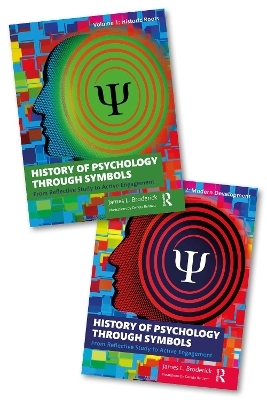
History of Psychology through Symbols
Routledge
978-1-032-54612-4 (ISBN)
- Titel z.Zt. nicht lieferbar
- Versandkostenfrei
- Auch auf Rechnung
- Artikel merken
This set of two volumes are ideal for anyone seeking a dynamic and engaging way of learning about or teaching the history of psychology. Both books would also be of interest to students, practitioners and scholars of science, philosophy, history and systems, art, and mental health and drug and alcohol treatment as well as those interested in living history on a daily basis.
Volume One
Volume One of The History of Psychology through Symbols provides a groundbreaking approach by expanding the roots of psychology beyond the Greeks to concurrent events during the same period (800 BCE-200 BCE) defined as the Axial Age by German-Swiss psychiatrist Karl Jaspers. The Axial Age emphasized seeking the universal connection that unites all humanity, a focus not on what one believed, but how one lived. This includes the human desire to connect to something greater, the totality of being human, explained by using symbol, the universal language.
The Volume describes the psychological implications of the Axial Age through the developments of Buddhism, Hinduism, Confucianism, Daoism, Judaism, Zoroastrianism as well as Greek thought. Rooted in the Axial Age Volume One explores how the Christian and Islamic eras influenced psychology which resulted in the Renaissance and the Scientific Revolution which provided the historic roots of modern psychology. Rejecting that science transcends historical events, the Volume provides a political, socio-economic, and cultural context for all the historic developments. The chapter on the History of Mental Illness provides inspiration for a new mental health system with specific recommendations for radical system reform. In the spirit of the Axial Age on the importance of how one lives, there is an emphasis on engagement with symbols and with specific exercises, called emancipatory opportunities, to apply the lessons of psychological history to daily life.
Volume Two
Volume Two of The History of Psychology through Symbols continues a groundbreaking approach of using symbol to deepen the understanding of psychological history as well as the importance of how one lives, an emphasis on engagement with symbols and with specific exercises, called emancipatory opportunities, to apply the lessons of psychological history to daily life.
From the birth of modern psychology in the laboratory of Wilhelm Wundt, Volume Two discusses how the early theories of voluntarism, structuralism, evolution, and pragmatism influenced the modern development of psychology. The importance of making unconscious shadow forces in science conscious is explored through the impact of the eugenic movement, the controversies surrounding the development of psychological testing, and current research biases in psychology. Volume Two describes how Clinical Psychology emerged as a powerful profession in mental health care. The Four Forces of Psychology are explored through their natural and hermeneutic science influences. Psychoanalytic and Jungian Analytical Psychology comprise the first force, behaviorism the second force, humanistic-existential the third force, and transpersonal psychology the fourth force which includes groundbreaking discussion of psychedelic history and research which could revolutionize mental health and drug and alcohol treatment. Rejecting that science transcends historical events, the Volume provides a political, socio-economic, and cultural context for modern psychology and all the Four Forces of Psychology.
Both volumes are also available for purchase separately.
Learn more about this groundbreaking text and its symbols on the special website: www.psychologyandsymbols.com.
James L. Broderick, PhD, ABPP is Board Certified in Clinical Psychology and currently in Private Practice in Santa Barbara California. Former Chair of the Clinical Psychology Program and current adjunct Professor at Pacifica Graduate Institute, Carpinteria California. Formerly, Director of Mental Health and Drug and Alcohol in Shasta and Santa Barbara Counties in California.
Volume One
1. History of Psychology through Symbols: From Reflective Study to Active Engagement
2. Symbols of the Axial Age: The Age of Psychological Transformation
3. Symbols of the Greek Era: The Foundation of Western Psychology
4. Symbols of the Hellenistic, Christian, and Islamic Eras
5. Symbols of Psychological Rebirth during the Renaissance, the Scientific Revolution, and the Enlightenment
6. The Symbols of the History of Mental Illness: Past, Present, and a New Vision for the Future
Volume Two
1. Symbols of the Birth of Modern Psychology: Voluntarism, Functionalism, the Darwinian Revolution, Eugenics, and Clinical Psychology
2. Symbols of Freudian and Relational Psychoanalysis: The First Force in Psychology
3. The World of Symbol – Jungian Analytical Psychology: First Force in Psychology
4. Symbols of Behaviorism, Neobehaviorism, and Cognitive Behavioral Psychology: The Second Force in Psychology
5. Symbols of Humanistic-Existential Psychology: The Third Force in Psychology
6. Symbols of Transpersonal Psychology – A Return to the Axial Age and Beyond: The Fourth Force in Psychology
| Erscheint lt. Verlag | 15.12.2023 |
|---|---|
| Zusatzinfo | 1 Line drawings, color; 199 Halftones, color; 60 Halftones, black and white; 260 Illustrations, color |
| Verlagsort | London |
| Sprache | englisch |
| Maße | 189 x 246 mm |
| Gewicht | 453 g |
| Themenwelt | Geisteswissenschaften ► Psychologie ► Allgemeine Psychologie |
| Geisteswissenschaften ► Psychologie ► Pädagogische Psychologie | |
| ISBN-10 | 1-032-54612-3 / 1032546123 |
| ISBN-13 | 978-1-032-54612-4 / 9781032546124 |
| Zustand | Neuware |
| Haben Sie eine Frage zum Produkt? |
aus dem Bereich
